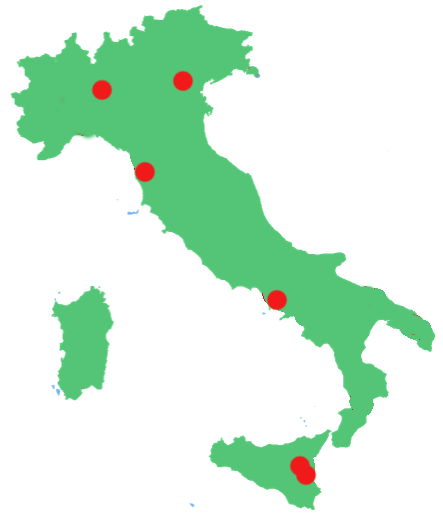Scientific activities of the various Research Units
Catania
-
Our research activity is devoted to the study of the structure and the dynamics of
many-body fermion systems. The interplay between nuclear structure and nuclear dynamics
plays a crucial role in the determination of important properties of nuclei with neutron
excess and, in particular, of the low-lying dipole states. In this connection, we have
proposed an experiment to detect the so called Pygmy Dipole Resonance (PDR) by using an
isoscalar probe. Such an experiment will be performed at the LNS in Catania next spring.
This interplay is also important in the study of the surface effects of the iso-vectorial
effective interaction in finite systems by means of the semiclassical molecular model
CoMD-II.
Most of our investigation is dedicated also to implement standard many-body theories like the second RPA with finite range effective interactions.This should provide a complementary information on collective modes of nuclei far from the stability line. Furthermore, the relevant role of proton-neutron pairing in N=Z nuclei is studied within the quartet formalism which has proved to be an appropriate tool for the treatment of this form of pairing.
LNS - Catania
-
The main motivation of our research is to extract information on the properties of the
nuclear effective interaction from the study of dissipative heavy ion reactions in the
energy range from the Coulomb barrier to the Fermi energies, by using the available stable
ions and, in perspective, exploiting the beams of new RIBF. In particular, we aim at
investigating the behavior of the isovector sector of the nuclear interaction and the
corresponding term (the symmetry energy) in the nuclear Equation of State (EOS), which
are still poorly known.
This analysis is carried out by simulating heavy ion reactions with the help of improved transport theories, which go beyond the mean-field framework, incorporating the effects of two-body correlations and fluctuations. Thus the main ingredients of these models are the mean-field effective interaction and the residual interaction, which is depicted in terms of nucleon-nucleon cross sections. We have recently concentrated on the study of low-energy reaction mechanims (fusion, deep-inelastic, transfer reactions, fragmentation) and nuclear collective excitations, with a special focus on new features appearing in neutron-rich nuclei.
We plan to improve our description by developing a suitable upgrade of the transport theory and employing new, recently proposed, effective interactions, which include also pairing correlations.
Milano
-
Our research is aimed at a microscopic understanding of the basic processes occurring
in the atomic nucleus, and at testing it against spectroscopic and reaction data.
- We try to constrain the properties of nuclear effective interactions and density functionals, especially concerning their dependence on nuclear asymmetry. In fact, this part of the nuclear EOS, which is still not well determined, plays an important role for the physics of heavy-ion collisions and neutron stars. The group focuses also on the spin-isospin channel of effective interactions and on the open issues in charge-exchange reactions and beta decay.
- We investigate the effects produced by the interplay of single-particle and collective degrees of freedom, which gives dynamical content to the shell model, leading to energy-dependent self-energies and strongly affecting the nuclear spectroscopic properties.The features of neutron-rich nuclei such as the structure of one- and two-neutron haloes, or the appearance of dipole strength at low-energy, are studied in detail and compared to experimental data obtained by RIB.
Our activity develops along two main lines.
Napoli
-
Our research activity concerns the spectroscopic study of nuclei within the shell
model using "realistic effective interactions", which are derived microscopically
from free nucleon-nucleon potentials by means of a perturbative approach. Our work
has contributed significantly to the theoretical assessment of this approach and
evidenced its ability in providing an accurate description of the nuclear structure
properties in various mass regions. Most of our studies have regarded the interpretation
of experimental data for exotic nuclei, focusing on near doubly magic nuclei as well as
on isotopic chains toward the neutron drip line to investigate the evolution of the
shell structure and collectivity.
At present we are still actively involved in this field with the aim of (i) supporting experiments performed at the new RIBF, (ii) explaining the effective interaction properties in finite nuclei in terms of nuclear-medium renormalizations of the free potential, and (iii) exploring the role of three-body forces in complex nuclei.
Our activity with realistic interactions covers also nuclear matter studies and the analysis of the dipole response in neutron rich nuclei within a multiphonon approach.
Padova
-
The research activity of this group covers a wide spectrum of subjects of the theoretical
nuclear physics that have the unifying characteristic of correlating the phenomenology to
fundamental microscopic approaches. The properties of the effective interaction are
studied within the shell model in nuclei far from stability, in particular in neutron-rich nuclei,
where changes in the magic numbers are observed, and in proton-rich nuclei. In this latter
case, the isospin symmetry breaking of the nuclear interaction is investigated through
the analysis of the energy differences between analogue states in isobaric multiplets.
The structure of exotic nuclei is also explored by using algebraic and group-theory methods.
The group is involved in the development of models for the description of reactions with weakly-bound nuclei and/or large neutron excess. Of particular interest are the studies of the excitation of the low-lying dipole modes, such as the PDR, via nuclear and electromagnetic probes, and of the role of the pairing interaction in two-particle transfer processes. Other important topics of research are the one- and two-proton spontaneous emission from excited states and the fusion reactions involving weakly bound nuclei.
Pisa
-
The starting point in our study is the elastic scattering of weakly bound nuclei,
by employing
optical potentials derived from microscopic models such as the folding model
with nuclear densities obtained by ab-initio calculations.
These potentials are necessary ingredients of breakup models of reactions
leading to bound and unbound nuclei. The latter can be studied by the missing
mass method or by coincidence experiments. The invariant mass is reconstructed
yielding the excitation energy spectrum, while the “core” momentum distributions
are obtained by gating on resonace peaks. Thus it is possible to study the effects
of the nuclear interaction in the short range regime (bound nuclei) and in the long
range regime (final state interaction effects). Some of the nuclei under study
(9C, 8C, 8B, 7Be,
6Be, etc…) belong to the explosive nucleosyntesis pp-chain
and present remarkable cluster features. Furthermore, two-proton emitters
nuclei (8C, 6Be) are mirror of two-neutron halo nuclei (8He,6He).
Thus they represent an interesting “laboratory” for investigating the isospin
invariance of the nuclear force. The effects of both nuclear and Coulomb potentials
are explored in the reaction mechanisms.
^ Back to Top


